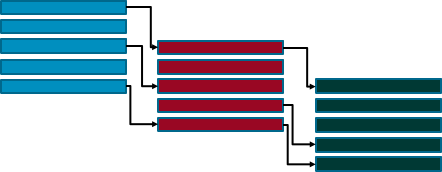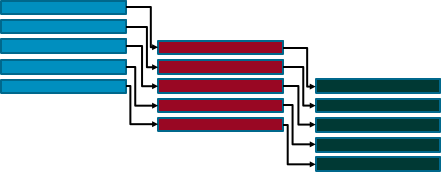It’s not unusual to see a methodology or framework move into the mainstream and immediately be widely misapplied. This can happen with well-meaning organizations that simply don’t have a firm foundation in the new method. They try to use it to solve the problems that are important to them, but the method they have chosen wasn’t really built to address those problems.
We are seeing this phenomenon play out today when it comes to Objectives and Key Results (OKRs). OKRs have become very popular as organizations strive to connect their strategies with execution, and quickly provide more value to their customers.
The intent of OKRs is to relentlessly align and focus organizations on the most important things they should do in the near future to meet their key goals. It is difficult for companies to innovate and evolve rapidly if they can’t achieve this focus; OKRs help solve that problem.
Many organizations, however, struggle with a similar, but slightly different problem: they can’t see clear, traceable lines from their strategies to the large body of work that is in flight (or proposed). They fear that their investments aren’t being correctly applied to the intended solutions. Further, they lack the feedback to understand if the implementation of these solutions is actually effective.
These companies don’t really want OKRs. Instead, they are implementing what I call Goals and Measures (G&M).
There is usually a very subtle difference in intent and implementation between OKRs and G&M, but the outcomes provided by the two implementations are very different. If an organization wants OKRs outcomes but implements G&M, or vice versa, they may fail, become disillusioned, and abandon goal management altogether. We want to avoid these problems.
Both methods have many similar traits. It wouldn’t be accurate to say that G&M doesn’t care about shorter timeboxes, or OKRs don’t include longer-term strategic objectives. But as you will see below, the difference in core principles is pretty stark.
Let’s look at the principles for each method, starting with OKRs:
Align, Aspire, Achieve
Objectives and Key Results:
- Uses shorter, consistent timeboxes (quarter)
- No connection to compensation/evaluation
- Aspirational
- Transparent
- Team-oriented, local focus
- Measures actual value of outcomes
Compare these to G&M:
Rigorous Traceability of Strategy to Execution
Goals and Measures:
- Connect work to funded priorities.
- Longer-term strategies are more important.
- Prove execution to the business.
- Capture expected value of execution efforts.
OKRs are explicitly focused on driving alignment of teams at each level, to give those teams focus and local accountability to provide value in the best way that they can for the most important near-term goals.
G&M validate work breakdown and assignments, and tie them back to strategic imperatives. G&M is all about traceability, visibility, and validation.
I’ll pause here to say that a G&M approach isn’t a bad thing if it’s what the customer needs to do. Tracing the relationship between funding of strategies and work performed is important to avoid waste and inefficient capacity allocation. Many customers struggle with understanding what work is in progress, a critical issue when assessing business performance.
A G&M approach won’t produce the same outcomes as OKRs, however, which organizations need to understand so they can set expectations correctly. An organization that wants the benefits of using OKRs but instead implements a G&M approach will struggle, and may become disillusioned with the whole idea.
How do we know whether an organization’s approach is one or the other? There are a few key attributes that indicate the approach being taken.
First - and most importantly - we must ask: do the objectives and their related work align, or do they cascade?
An aligned model does not require 100% traceability, and it’s the way OKRs should be implemented. The aligned model lets teams within an organization prioritize by choosing the very best ways that they can support higher level OKRs and drive the fastest possible success. An aligned hierarchy looks like this:

However, the point of a G&M approach is traceability. It cascades relationships down the hierarchy, and looks more like this:

It can be very time consuming to create and maintain a fully-traced hierarchy, and they tend to be driven top-down. Teams can’t always effectively manage their work in-flight, because work tends to be pushed down. Laszlo Bock, a former VP at Google, said in the book Measure What Matters, "Having goals improves performance. Spending hours cascading goals up and down the company, however, does not. It takes way too much time and it’s too hard to make sure all the goals line up." (p. 86)
A second attribute to check is the desire or need for innovation and aspiration. If an organization expects close to 100% completion for each traced element, they will be more risk averse. These organizations are not trying to aspire, stretch, and do more. They are looking to drive efficiency in their “business as usual” by managing what they do very closely, usually with a top-down G&M approach.
Organizations that use OKRs, on the other hand, look for innovation. In Measure What Matters, author and OKRs expert John Doerr said, "By definition, Objectives are significant, concrete, action-oriented, and (ideally) inspirational. When properly designed and deployed, they’re a vaccine against fuzzy thinking and ineffective execution." (p. 7)
Since OKRs are designed to challenge, be ambitious, and inspire, organizations that use OKRs are more comfortable with risk, and actually expect less - sometimes much less - than 100% success in meeting their objectives. For them, it is as much about the journey as it is reaching a destination. But they know that if they make the maximum effort, they will get further than they would otherwise.
A final, important point is that tools developed specifically for OKRs might also support a G&M implementation perfectly well. Unfortunately, this adaptability can also cause organizations with a specific purpose in mind to think they are implementing the right tool, but by allowing internal constraints or a simple lack of understanding to guide them, they actually find themselves implementing a method best suited for other purposes.
For example, a car developed to meet all the needs of the consumer in 2022 can certainly still be driven in ways that are ill-advised like going too fast or steering erratically. It’s up to the driver to ensure that the car is operated appropriately. However, a particular driver may want to take advantage of the car’s "extra" capabilities and race that car. This is a perfectly fine application for the automobile, as long as the driver does so with a full understanding of all that their decision to race entails.
Just as we said above with OKRs or G&M, it isn’t that one method is better than the other. It is about setting and managing the right expectations based on the outcomes an organization seeks.

Ian McGinnis
Ian McGinnis is an architect of agile solutions with over 30 years of experience in software development. At Rally, he serves as an Executive Advisor, working directly with Fortune 100 companies to help them adopt true business agility. Ian is passionate about helping organizations figure out how to make business...
Other resources you might be interested in
Automic Automation Cloud Integration: SAP S/4 HANA Application Jobs Integration
Simplify your SAP S/4HANA job management. Integrate with Automic Automation for central configuration, monitoring, and orchestration of all your enterprise jobs.
Automic Automation Cloud Integration: OpenSSH Integration
Master Open SSH automation. Use Automic Automation for centralized control, secure file transfer, command execution, and full job monitoring.
3 Questions I Expect You to Ask Me
Ask these questions to gain a deeper understanding of a vendor. Find a partner who can solve today’s challenges and prepare you for what’s next.
Carrier-Grade Network Observability: A Technology Brief for Telco Network Operations
Network Observability by Broadcom unifies data to provide contextual, AI-enabled insights for superior service availability, accelerated MTTR and improved MTTI, reduced operational costs, and the...
Rally Office Hours: December 4, 2025
Get the latest Rally updates, including a new Release Tracking page, and hear Q&A on revision history reporting, custom boards, and capacity planning.
You've Found the Waste In Your Network Operations. Now What?
Leverage the Six Sigma framework to gain a roadmap for converting network data into permanent optimizations. Start systematically eliminating network issues.
AAI Integrations: Control-M
This course explains how to install, configure, and secure the integration between Automation Analytics & Intelligence (AAI) and Control-M.
The Silent Sabotage of Configuration Drift
See how manual network changes lead to configuration drift, which can cause security holes, compliance violations, and network outages.
AAI - Configuring & Responding to Jobstream Alerts
This course walks you through how jobstream alerts work in AAI, and how to tailor them to your workload needs.